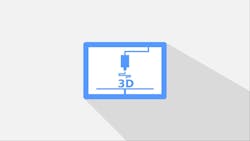Tech Insights: 3D printing catapults R&D into the fast lane
Originally pretty much an additive polymer technology during its inception in the ‘80s, 3D printing now enables designers to create prototypes of any shape or geometry with great efficiency, using a variety of processes, materials, and types of digital input. It has been used in manufacturing, medical, industry, and sociocultural sectors. It can be used to transform food into shapes, make bikinis, shoes and dresses, automobile parts, or even enameled pottery, and more. If you want to keep up developments in the additive manufacturing market, don’t blink your eyes. Here are some recent developments:
The electrodes hiding in my printer
Researchers at the University of California Santa Cruz (UCSC) and Lawrence Livermore National Laboratory (LLNL) have reported unprecedented performance results using a new supercapacitor electrode. The team used 3D printing to fabricate electrodes using a printable graphene aerogel, building a porous, three-dimensional scaffold that is loaded with manganese oxide—a commonly used pseudocapacitive material. “The problem for pseudocapacitors is that when you increase the thickness of the electrode, the capacitance decreases rapidly because of sluggish ion diffusion in bulk structure,” said Yat Li, professor of chemistry and biochemistry at USCS in a university news release. “So the challenge is to increase the mass loading of pseudocapacitor material without sacrificing its energy storage capacity per unit mass or volume,” Li explained.1
One great printing job for mankind?
“New Space” players like SpaceX and Blue Origin make use of 3D printed components in their vehicles. Even NASA has been dipping their proverbial toe in the additive manufacturing waters, testing printed parts for the Space Launch System’s RS-25 engine. It would be safe to say that from this point forward, most of our exploits off of the planet’s surface will involve additive manufacturing in some capacity.
But one of the latest players to enter the commercial spaceflight industry, Relativity Space, thinks we can take the concept even farther. Not content to just 3D print rocket components, founders Tim Ellis and Jordan Noone believe the entire rocket can be printed. Minus electrical components and a few parts which operate in extremely high stress environments such as inside the pump turbines, Relativity Space claims up to 95% of their rocket could eventually be produced with additive manufacturing.2
3D-printed lithium-ion batteries enter the fray
Electric vehicles and most electronic devices, such as cell phones and laptop computers, are powered by lithium-ion batteries. Until now, manufacturers have had to design their devices around the size and shape of commercially available batteries. But researchers have developed a new method to 3D print lithium-ion batteries in virtually any shape. They report their results in ACS Applied Energy Materials.
Most lithium-ion batteries on the market come in cylindrical or rectangular shapes. Therefore, when a manufacturer is designing a product—such as a cell phone—they must dedicate a certain size and shape to the battery, which could waste space and limit design options. Theoretically, 3D-printing technologies can fabricate an entire device, including the battery and structural and electronic components, in almost any shape. However, the polymers used for 3D printing, such as poly (lactic acid) (PLA), are not ionic conductors, creating a major hurdle for printing batteries. Christopher Reyes, Benjamin Wiley, and their colleagues wanted to develop a process to print complete lithium-ion batteries with an inexpensive 3D printer.
The researchers increased the ionic conductivity of PLA by infusing it with an electrolyte solution. In addition, they boosted the battery’s electrical conductivity by incorporating graphene or multi-walled carbon nanotubes into the anode or cathode, respectively. To demonstrate the battery’s potential, the team 3D printed an LED bangle bracelet with an integrated lithium-ion battery. The bangle battery could power a green LED for about 60 seconds. According to the researchers, the capacity of the first-generation 3D-printed battery is about two orders of magnitude lower than that of commercial batteries, which is too low for practical use. However, they say that they have several ideas for increasing the capacity, such as replacing the PLA-based materials with 3D-printable pastes.3
Metal 3D printing goes mainstream
In September, at the International Manufacturing Technology Show, Hewlett-Packard’s 3D Printing Business launched HP Metal Jet—an advanced 3D printing technology designed for the high-volume manufacturing of production-grade metal parts. The HP Metal Jet is being deployed by manufacturers that include GKN Powder Metallurgy and Parmatech for the factory production of final parts. Customers placing orders include global stalwarts Volkswagen and Wilo as well as vertical-market manufacturers, such Primo Medical Group and OKAY Industries.
In April, GE Additive came out with the Arcam EBM Spectra H high-heat 3D printer, meant to print with metals prone to cracking. The system is designed to print parts at temperatures exceeding 1000°C, making it suitable for materials like aluminide and Alloy 718.4
References
1.“3D-printed capacitor shows promise,” Design News, Oct. 29, 2018”
https://www.designnews.com/electronics-test/3d-printed-supercapacitor-shows-promise/61813435659686
2.“Relativity Space’s Quest to 3D Print Entire Rockets,” www.hackaday.com, Oct. 30, 2018
Relativity Space’s Quest to 3D Print Entire Rockets
3. “3D-printed lithium-ion batteries enter the fray” EE-Evaluation Engineering, Oct. 18, 2018, https://www.evaluationengineering.com/3d-printed-lithium-ion-batteries-enter-the-fray
4. “Metal 3D Printing Goes Mainstream,” Design News, Oct. 26, 2018, https://www.designnews.com/automation-motion-control/metal-3d-printing-goes-mainstream/118358730959699
